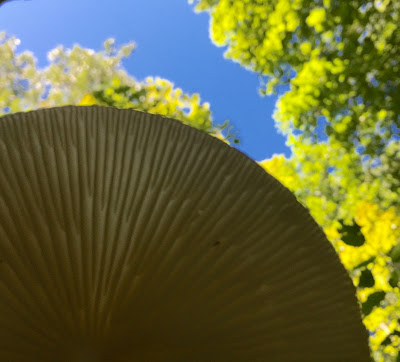I first saw my turkey tail patch growing in the early summer following a lot of spring rain on a stump we use for chopping firewood. I wasn't sure, as I'm a novice mycologist, but it had the markers: the ringed color patterns and the nested groupings of the caps. Also, the top side of the caps were fuzzy to the touch. I checked my trusty reference guide and it said to look for whitish spores. But I couldn't see any spores. Perhaps those emerging caps were too young to produce spores. (note to self: Ask an experienced mycologist when the caps typically start producing spores. My guess is there are a number of factors, like air temperature and humidity, in addition to the maturity of the mushrooming body.)
 |
| Turkey Tail emerging, July 11, 2016 |
I didn't think my turkey tail -- and yes, I call it MY turkey tail, for I have abounding, familial affection for my back patio patch -- would thrive in its volunteer location here in Bloomington, Indiana. During midsummer this spot was destined to get full sun for several hours a day, and the stump is too heavy to move without a good reason.
But, before I asked my 6'4" son to roll it back under the shade of the deck so the mushrooms wouldn't struggle in the heat, it rained. It rained a lot here--all summer l-o-n-g. While the western states fried, the midwest flooded and my turkey tail thrived. Here's my mushroom stump a month later.
 |
| New growth after the storm, August 14th |
 |
| The other side of the stump with another, shorter-lived species, August 18 |
This past weekend I photographed my turkey tail again, after a couple of weeks of "normal" late summer weather, in other words, HOT. The patch is clearly thriving despite the heat. I love the green rings and wonder why one section of caps has developed a new color scheme. When I shared my pictures with my Mycelium Running seminar tribe, one cautioned my identification, saying she had encountered a turkey tail look-alike.
 |
| Is MY turkey tail really Trametes versicolor, or an imposter? September 10, 2016 |
 |
| Under the cap you can see the whitish pore openings where the spores come out -- shot with a macro lens. |
So I asked a local mycology prof, Dr. Michael R. Tansey of Indiana University, to verify or set me straight. From the two photos pictured above, this is what he said:
"This is Turkey-tail. It is our most common mushroom. It is very common. I have been out walking today, and it is abundant. FYI: Most experienced mushroom people agree that what we call the Turkey-tail is, at the level of analysis of the DNA, many different species. Indeed, I have seen unpublished DNA data from our local specimens, and they cannot be one "real" species. I remember one of the most experienced wood-rot fungi experts, years ago, telling me that it must be a dozen species."
Ta Da! I'm thrilled I correctly identified fungi--even if not DNA-specific in my ID--in the wilds of my back yard. And now that the sun has dropped lower and the stump is in the shade for more of the day, I doubt anything will disturb my turkey tail, until we have really cold weather. Remember, turkey tail is everywhere. See if you can find some in your neighborhood.
To learn more about why I write sci-fi eco-adventures, and to find out more about my work-in-progress and how writing
Mission to Blue Grannus requires my research into fungi and myco-remediation, tap on
KHBrower.com.
P.S. If anyone has thoughts or recipes about making a medicinal extract, please send them my way. This literary scientist is ready to try most anything.



















